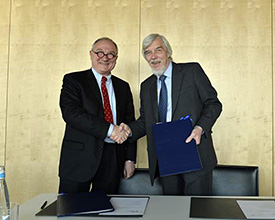| English Page |
CERN and ESA sign cooperation agreement |
 |
 |
| 31 March 2014 | ||
Geneva, 28 March 2014. At a ceremony today at Geneva airport, CERN and ESA signed a framework agreement for future cooperation on research and technology in areas of mutual interest. Future areas may include the development and characterization of innovative materials for applications in extreme conditions and for cutting-edge scientific performances, the development of new micro-technologies to be applied in miniaturized distributed sensor systems and the development and testing of high-performance detectors for high-energy physics experiments and space payloads. Mauro Dell’Ambrogio, the State Secretary for Education, Research and Innovation of Switzerland, highlighted how the two institutions complement each other as examples of successful European collaboration and worldwide excellence in science and technology: “CERN and ESA are two examples that attest to the approach of European collaboration for global benefit.” Geneviève Fioraso, Minister for Higher Education and Research of France, stated that, “This cooperation agreement brings concrete expression to the long shared history of two international organisations that are emblematic of the strength of European science: CERN and ESA. This joining together in the exploration of the infinite, from the infinitely large that is the focus of the sciences of the Universe to the infinitely small in high energy physics, opens up new avenues for science and technology, bringing progress and strengthening European industry.” “CERN and ESA have common roots and share a long history of pioneering research work in their respective fields,” said CERN Director General Rolf Heuer. “This new cooperation agreement will foster synergies between the expertise, know-how and facilities available in the two Organizations.” This year is CERN’s 60th anniversary and ESA’s 50th, making the signature an opportunity to celebrate the memory of a scientist who was a founding father of both organizations: the Italian, Edoardo Amaldi (5 September 1908 – 5 December 1989). Amaldi had an unshakeable belief in the open nature of science and the need for international cooperation. After participating in the creation of CERN during the 1950s, he became Secretary General of the provisional organization. Then, in 1958 when CERN was firmly established, he joined forces with French physicist Pierre Auger to urge European governments to set up a European organisation for space research, based on the CERN model. Their vision led to the founding of the European Space Research Organisation (ESRO), which later became ESA. During the ceremony, ESA Director General Jean-Jacques Dordain presented Heuer with copies of letters by Amaldi in which he lays out his concern for peace, and the role science should play in fostering it. These letters were flown aboard ESA’s Automated Transfer Vehicle 3 – a spacecraft named in Amaldi’s honour. The ceremony took place in the presence of members of Amaldi’s family, along with Research Ministers and State Secretaries from Belgium, France, Italy and Switzerland. “ESA and CERN are the daughters of visionaries like Amaldi,” said Dordain, “testimony that, when we share the same challenging objectives and join forces, Europe is at the leading edge of progress, innovation and growth.” Today, ESA’s space missions and CERN’s ground-based high-energy physics experiments address fundamental questions linked to the physical properties of matter, energy and space, and to the origin and evolution of the Universe. As a result, the two Organizations have common interests in several technological fields. Their technologies must be robust and reliable over several years, highly autonomous and offer the utmost precision. Fostering reciprocal knowledge transfer actions in the selected areas can therefore bring very important mutual benefits. “The research programmes of both Organizations will benefit a lot from this cooperation agreement, a framework in which fruitful exchanges will surely blossom,” said Sergio Bertolucci, CERN’s Director for Research and Computing. “ESA’s Planck satellite is already a CERN recognized experiment and we look forward to further collaboration with ESA.” |

















